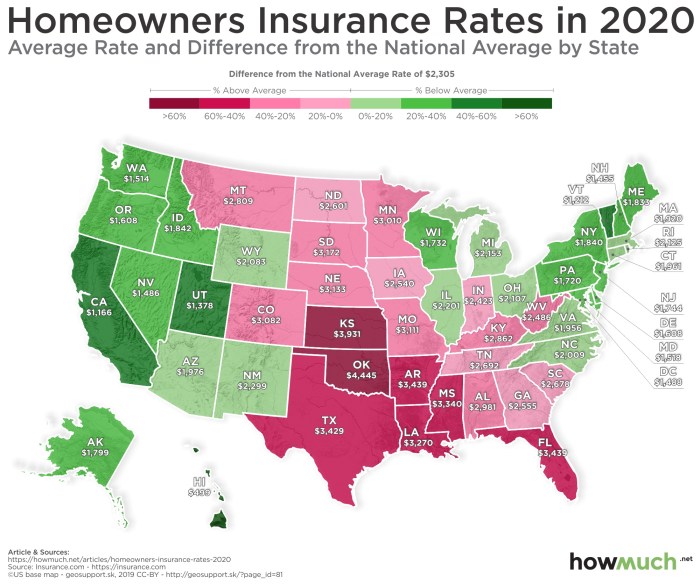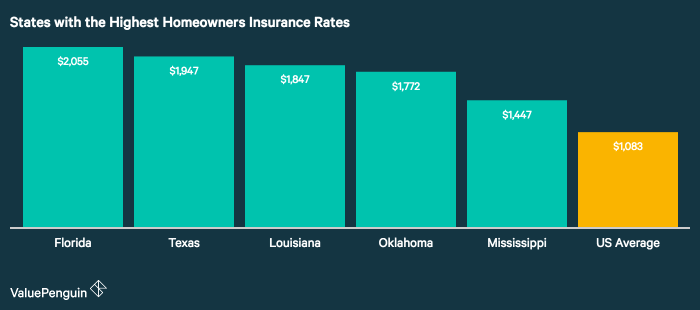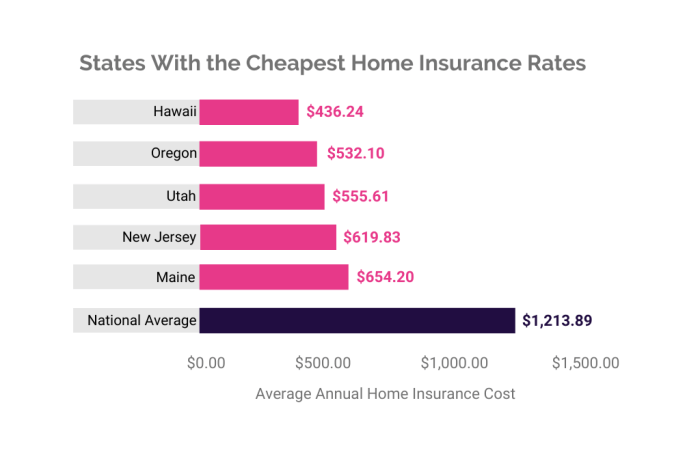Securing your home is a significant financial commitment, and understanding the intricacies of home insurance is paramount. This guide delves into the factors that influence average home insurance rates, providing a clear picture of how various elements contribute to the final premium. From location and home features to coverage options and insurer comparisons, we’ll navigate the complexities to empower you with the knowledge needed to make informed decisions about protecting your most valuable asset.
We’ll explore the interplay between location risk, property characteristics, and personal financial standing, demonstrating how these factors impact your insurance costs. Furthermore, we’ll examine the different types of coverage available, the significance of deductibles, and the potential for cost savings through discounts and smart policy choices. By the end, you’ll possess a robust understanding of average home insurance rates and how to navigate the process of securing affordable and comprehensive coverage.
Factors Influencing Average Home Insurance Rates

Several key factors contribute to the variability of home insurance premiums. Understanding these elements allows homeowners to better anticipate their costs and potentially take steps to reduce them. These factors interact in complex ways, meaning a single element rarely dictates the final price.
Location’s Impact on Home Insurance Costs
Geographic location significantly influences home insurance rates due to varying risks. Areas prone to natural disasters, such as hurricanes, earthquakes, wildfires, or floods, command higher premiums. For instance, coastal properties in Florida or California often face substantially higher rates than those in less disaster-prone states like Iowa or Nebraska. Similarly, areas with high crime rates may also see increased premiums due to the heightened risk of theft or vandalism. Conversely, areas with low crime rates and minimal risk of natural disasters generally enjoy lower insurance costs.
Home Age and Construction Materials
Older homes typically carry higher insurance premiums than newer ones. This is because older homes may have outdated plumbing, electrical systems, and building materials that are more susceptible to damage. The materials used in construction also play a significant role. Homes built with fire-resistant materials, such as brick or concrete, generally have lower premiums than those constructed with wood, which is more vulnerable to fire damage. For example, a well-maintained, modern brick home might have lower premiums than a similarly sized older wood-frame house.
Insurance Rates for Different Home Types
The type of dwelling significantly impacts insurance costs. Single-family homes usually have the most comprehensive coverage and, therefore, may have higher premiums than condos or townhouses. Condos and townhouses typically share common walls and amenities, often reducing individual liability and the overall insurance cost. The homeowner’s association (HOA) often covers exterior maintenance and repairs, lowering the individual’s insurance burden. Townhouses often fall somewhere between single-family homes and condos in terms of premium costs, depending on the specifics of the development and coverage.
Credit Score’s Role in Determining Insurance Rates
Many insurance companies use credit-based insurance scores to assess risk. A higher credit score often correlates with a lower insurance premium. This is because individuals with good credit histories are statistically less likely to file claims. Conversely, a lower credit score can result in higher premiums, reflecting a perceived higher risk to the insurance company. The exact impact of credit score varies by state and insurance company, but it’s a significant factor for many.
Factors Influencing Premium Costs
| Factor | High-Risk (Higher Premium) | Low-Risk (Lower Premium) | Example |
|---|---|---|---|
| Location | Coastal area prone to hurricanes, high crime rate | Rural area with low crime, minimal natural disaster risk | Florida coast vs. Iowa farmland |
| Home Age & Construction | Older home, wood frame, outdated systems | Newer home, brick construction, modern systems | 1950s wood-frame house vs. new brick home |
| Home Type | Large single-family home | Condo or townhouse | Detached house vs. condo unit |
| Credit Score | Low credit score | High credit score | Credit score below 600 vs. credit score above 750 |
Coverage Options and Their Impact on Costs

Choosing the right home insurance coverage significantly impacts your premiums. Understanding the various options and their associated costs is crucial for securing adequate protection without overspending. This section details common coverage types, their cost variations, and the influence of deductibles and additional coverage choices.
Common Home Insurance Coverages and Costs
Home insurance policies typically include several core coverages. Dwelling coverage protects the physical structure of your home, typically covering repairs or rebuilding costs after a covered event like a fire or windstorm. Liability coverage protects you financially if someone is injured on your property or you damage someone else’s property. Personal property coverage protects your belongings inside your home from damage or theft. Additional living expenses coverage helps cover temporary housing and living costs if your home becomes uninhabitable due to a covered event. The cost of each coverage component varies depending on factors like your home’s location, age, and value, as well as the policy limits you select. For example, a homeowner with a $500,000 home in a high-risk area might pay significantly more for dwelling coverage than someone with a $200,000 home in a low-risk area. Similarly, higher liability limits result in higher premiums.
Coverage Levels and Premium Costs
Home insurance policies are often offered in different coverage levels: basic, standard, and comprehensive. Basic policies typically offer minimal coverage, focusing on liability and dwelling protection with lower limits. Standard policies provide broader coverage, including more extensive personal property protection and higher liability limits. Comprehensive policies offer the most extensive coverage, including additional protection against a wider range of perils and higher coverage limits. The premium difference between these levels can be substantial. A basic policy might cost significantly less upfront, but leave you vulnerable in the event of a major loss. A comprehensive policy offers peace of mind but comes with a higher premium. For instance, a basic policy might cost $800 annually, while a comprehensive policy for the same home could cost $1500 or more.
Impact of Deductibles on Premiums
The deductible is the amount you pay out-of-pocket before your insurance coverage kicks in. Choosing a higher deductible generally lowers your premium because you are accepting more financial risk. Conversely, a lower deductible leads to higher premiums as the insurance company assumes more of the risk. For example, a $1,000 deductible might reduce your annual premium by $100-$200 compared to a $500 deductible. The optimal deductible depends on your risk tolerance and financial capacity.
Additional Coverage Options and Costs
Many homeowners opt for additional coverage beyond the standard policy. Flood insurance, earthquake insurance, and personal umbrella liability insurance are common examples. These policies are often purchased separately and carry additional costs. Flood insurance is particularly important in flood-prone areas and is not typically included in standard home insurance policies. Earthquake insurance is also usually purchased separately and is necessary in seismically active regions. A personal umbrella liability policy provides extra liability coverage beyond the limits of your home and auto insurance. The cost of these additional coverages varies greatly based on location, risk assessment, and the coverage limits chosen.
Cost-Effectiveness of Various Coverage Options
The cost-effectiveness of different coverage options depends on individual circumstances and risk profiles.
- Basic Policy: Lowest premium, but limited protection. Cost-effective only for those with low risk tolerance and limited assets.
- Standard Policy: Balanced approach offering decent coverage at a moderate cost. Generally a good option for most homeowners.
- Comprehensive Policy: Highest premium, but offers the most extensive protection. Cost-effective for those with high-value assets and a low risk tolerance.
- High Deductible with Standard Policy: Can significantly lower premiums while still offering substantial coverage. A good option for those comfortable with higher out-of-pocket expenses.
- Additional Coverages (Flood, Earthquake, Umbrella): Essential in high-risk areas or for those with significant assets. The cost is justified by the protection offered.
Comparing Insurance Providers and Their Rates

Choosing the right home insurance provider can significantly impact your overall cost. Understanding how different companies calculate premiums and the factors influencing those calculations is crucial for securing the best value. This section compares average rates from major providers, highlights key features, and explains the premium calculation process.
Direct comparison of average home insurance rates across all providers is difficult due to the variability in coverage, location, and individual risk profiles. However, we can illustrate the general differences in pricing and approaches. The following table provides a simplified representation of potential average annual premiums, emphasizing that these are illustrative and not a definitive guide.
Average Home Insurance Rates from Major Providers
| Provider | Average Annual Premium (Illustrative) | Key Features |
|---|---|---|
| Provider A | $1200 | Strong customer service, robust online tools, various discounts. |
| Provider B | $1000 | Competitive pricing, basic coverage options, limited online features. |
| Provider C | $1350 | High-end coverage options, specialized add-ons, personalized service. |
| Provider D | $1150 | Bundle discounts, strong claims processing reputation, average customer service. |
Note: These figures are for illustrative purposes only and actual premiums will vary based on location, coverage level, home features, and individual risk factors. Always obtain personalized quotes from multiple providers.
Methods for Calculating Home Insurance Premiums
Insurance companies utilize complex algorithms to determine premiums, factoring in numerous variables. These typically include:
- Location: Areas prone to natural disasters (hurricanes, earthquakes, wildfires) generally command higher premiums.
- Home Value: The higher the value of your home, the more expensive the insurance.
- Coverage Level: Comprehensive coverage costs more than basic coverage.
- Deductible: Choosing a higher deductible reduces your premium but increases your out-of-pocket expense in case of a claim.
- Claims History: A history of filing claims can lead to higher premiums.
- Credit Score: In many states, credit scores are used to assess risk, impacting premium costs.
- Security Features: Homes with security systems (alarms, fire sprinklers) often qualify for discounts.
Impact of Discounts on Home Insurance Costs
Many insurers offer discounts to incentivize risk mitigation and customer loyalty. These can substantially reduce your premium. Examples include:
- Multi-policy discounts: Bundling your home and auto insurance with the same provider often results in a significant discount (e.g., 10-15% or more).
- Security system discounts: Installing a monitored security system can lower your premium by 5-10% or more, reflecting the reduced risk of theft or damage.
- Home safety discounts: Upgrades like smoke detectors, fire-resistant roofing materials, and impact-resistant windows can also lead to premium reductions.
- Loyalty discounts: Long-term customers may receive discounts for their continued business.
For example, a homeowner with a $1200 annual premium could save $120 (10%) with a multi-policy discount and another $60 (5%) with a security system discount, resulting in a total annual savings of $180.
Ending Remarks
Ultimately, understanding average home insurance rates involves a multifaceted assessment of risk, coverage needs, and available options. By carefully considering the factors discussed – location, home characteristics, coverage levels, and insurer choices – homeowners can effectively manage their insurance costs while ensuring adequate protection. Remember that proactive steps, such as home improvements and responsible financial management, can significantly contribute to lowering premiums. This guide serves as a starting point; consulting with an insurance professional for personalized advice is always recommended.
Questions Often Asked
What is the average cost of home insurance in the US?
The average cost varies significantly based on location, home value, coverage, and other factors. There’s no single national average, but online resources and insurance comparison websites can provide estimates for your specific area.
How often are home insurance rates reviewed?
Rates are typically reviewed annually, though adjustments can occur more frequently based on changes in risk factors or policy modifications.
Can I get home insurance if I have a poor credit score?
Yes, but a poor credit score will likely result in higher premiums. Insurance companies consider credit scores as an indicator of risk.
What happens if I need to file a claim?
Contact your insurance provider immediately. They will guide you through the claims process, which typically involves providing documentation and cooperating with their investigation.